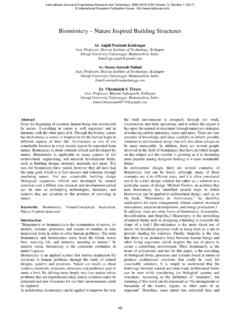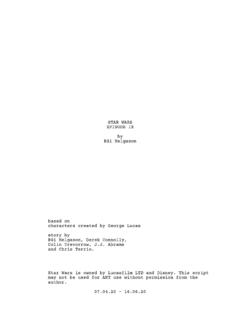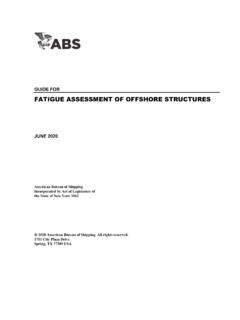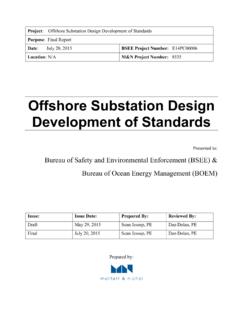Transcription of DNVGL-RP-C205 Environmental conditions and ... - ULisboa
1 The electronic pdf version of this document, available free of chargefrom , is the officially binding GL ASRECOMMENDED PRACTICEDNVGL-RP-C205 Edition August 2017 Environmental conditions andenvironmental loadsFOREWORDDNV GL recommended practices contain sound engineering practice and guidance. DNV GL AS August 2017 Any comments may be sent by e-mail to service document has been prepared based on available knowledge, technology and/or information at the time of issuance of thisdocument. The use of this document by others than DNV GL is at the user's sole risk. DNV GL does not accept any liability or responsibilityfor loss or damages resulting from any use of this document. Changes - currentRecommended practice DNVGL-RP-C205 . Edition August 2017 Page 3 Environmental conditions and Environmental loadsDNV GL ASCHANGES CURRENTG eneralThis document supersedes the April 2014 edition of purpose of the revision of this service document is to comply with the new DNV GL document reference code system and profile requirements following the merger between DNV and GL in 2013.
2 Changes mainly consist of updated company name and references to other documents within the DNV GL references in this service document may refer to documents in the DNV GL portfolio not yet published (planned published within 2017). In such cases please see the relevant legacy DNV or GL document. References to external documents (non-DNV GL) have not been correctionsIn addition to the above stated changes, editorial corrections may have been made. ContentsRecommended practice DNVGL-RP-C205 . Edition August 2017 Page 4 Environmental conditions and Environmental loadsDNV GL ASCONTENTSC hanges 1 Scope and Relationship to other 10 Section 2 Wind Introduction to wind Wind Wind Transient wind 3 Wave Regular wave Wave Wave Short term wave Long term wave Extreme value 4 Current and tide Current Tide 5 Wind Wind Wind The shape ContentsRecommended practice DNVGL-RP-C205 .
3 Edition August 2017 Page 5 Environmental conditions and Environmental loadsDNV GL Wind effects on Dynamic Model Computational fluid 106 Section 6 Wave and current induced loads on slender Normal Tangential force on inclined Lift Torsion Hydrodynamic coefficients for normal Drag coefficients for circular Reduction factor due to finite Inertia Shielding and amplification Risers with buoyancy Loads on jack-up leg Small volume 3D 132 Section 7 Wave and current induced loads on large volume Hydrostatic and inertia Wave frequency Mean and slowly varying High frequency Steady current 160 Section 8 Air gap and wave Air Wave-in-deck loads on floating Computational fluid Wave impact loads on slender Wave impact loads on Breaking wave 180 ContentsRecommended practice DNVGL-RP-C205 .
4 Edition August 2017 Page 6 Environmental conditions and Environmental loadsDNV GL Fatigue damage due to wave 182 Section 9 Vortex induced Basic concepts and Implications of Principles for prediction of vortex induced Vortex induced hull Wind induced vortex Current induced vortex Wave induced vortex Methods for reducing vortex induced 212 Section 10 Hydrodynamic model When is model testing Modelling and calibration of the Restrictions and simplifications in physical Calibration of physical model Measurements of physical parameters and Nonlinear extreme loads and Data acquisition, analysis and Scaling 231 Appendix A Torsethaugen two-peak General Simplified B Nautic zones for estimation of long-term wave C Scatter D Added mass 247 Appendix E Drag 252 Appendix F Physical practice DNVGL-RP-C205 .
5 Edition August 2017 Page 7 Environmental conditions and Environmental loadsDNV GL ASSECTION 1 IntroductionThis recommended practice (RP) gives guidance for modelling, analysis and prediction of environmentalconditions as well guidance for calculating Environmental loads acting on structures. The loads are limitedto those due to wind, wave and current. The RP is based on state of the art within modelling and analysisof Environmental conditions and loads and technical developments in recent research and developmentprojects, as well as design experience from recent and ongoing basic principles applied in this RP are in agreement with the most recognized rules and reflect industrypractice and latest on Environmental conditions is given in , and , while guidance on the calculationof Environmental loads is given in , , , and Hydrodynamic model testing iscovered in ObjectiveThe objective of this RP is to provide rational design criteria and guidance for assessment of loads on marinestructures subjected to wind, wave and current Scope and Environmental Environmental conditions cover natural phenomena, which may contribute to structural damage.
6 Operation disturbances or navigation failures. The most important phenomena for marine structures are: wind waves current phenomena are covered in this Phenomena, which may be important in specific cases, but not covered by this RP include: ice earthquake soil conditions temperature fouling The Environmental phenomena are usually described by physical variables of statistical nature. Thestatistical description should reveal the extreme conditions as well as the long- and short-term a reliable simultaneous database exists, the Environmental phenomena can be described by The Environmental design data should be representative for the geographical areas where thestructure will be situated, or where the operation will take place. For ships and other mobile units whichoperate world-wide, Environmental data for particularly hostile areas, such as the North Atlantic Ocean, maybe practice DNVGL-RP-C205 .
7 Edition August 2017 Page 8 Environmental conditions and Environmental loadsDNV GL Empirical, statistical data used as a basis for evaluation of operation and design must cover asufficiently long time period. For operations of a limited duration, seasonal variations must be taken intoaccount. For meteorological and oceanographical data 20 years of recordings should be available. If the datarecord is shorter the climatic uncertainty should be included in the Environmental Environmental loads are loads caused by Environmental Environmental loads to be used for design shall be based on Environmental data for the specificlocation and operation in question, and are to be determined by use of relevant methods applicable for thelocation/operation taking into account type of structure, size, shape and response Relationship to other documentsThis RP provides the basic background for Environmental conditions and Environmental loads applied in DNVGL's standards and recommended practices and is considered to be a supplement to relevant national ( ) and international ( ISO) rules and DNV GL recommended practices give specific information on Environmental loading for specific marinestructures.
8 Such recommended practices include:Document codeTitleDNVGL-RP-C103 Column-stabilised unitsDNVGL-RP-C206 Fatigue methodology of offshore shipsDNVGL-RP-F105 Free spanning pipelinesDNVGL-RP-F204 Riser fatigueDNVGL-RP-F205 Global performance analysis of deepwater floating ReferencesReferences are given at the end of each of to These are referred to in the AbbreviationsAbbreviationDescriptionALSa ccidental limit stateBEMboundary element methodCFcross flowCFDcomputational fluid dynamicsCMAconditional modelling approachCOGcenter of gravityCQCcomplete quadratic combinationDVMdiscrete vortex methodRecommended practice DNVGL-RP-C205 . Edition August 2017 Page 9 Environmental conditions and Environmental loadsDNV GL ASAbbreviationDescriptionEOFempirical orthogonal functionsFDfinite differenceFEMfinite element methodFLSfatigue limit stateFPSO floating production and storage and offloadingFVfinite volumeGBSgravity based structureHAThighest astronomical tideHFhigh frequencyILin-lineLATlowest astronomical tideLFlow frequencyLNGliquefied natural gasLSleast squaresLTFlinear transfer functionMHWN mean high water neapsMHWS mean high water springsMLEmaximum likelihood estimationMLMmaximum likelihood modelMLWN mean low water neapsMLWS mean low water springsMOMmethod of momentsPIVparticle imaging velocimetryPMPierson-MoskowitzPOTpeak over thresholdQTFquadratic transfer functionRAOresponse amplitude operatorSRSS square root of sum of squaresSWLstill water levelTLPtension leg
9 PlatformULSultimate limit stateVICvortex in cellVIMvortex induced motionRecommended practice DNVGL-RP-C205 . Edition August 2017 Page 10 Environmental conditions and Environmental loadsDNV GL ASAbbreviationDescriptionVIOvortex induced oscillationsVIVvortex induced vibrationsVOFvolume of fluidWFwave Latin symbolsa0still water air gapainstantaneous air gapAdynamic amplification factorAcross-sectional areaA(z)moonpool cross-sectional areaA1V/L, reference cross-sectional area for riser with buoyancy elementsACcharnock's constantACwave crest heightACFcross flow VIV amplitudeAkjadded mass matrix elementsarrelative accelerationARreference area for 2D added mass coefficientATwave trough depthBbowen ratioB1linear damping coefficientBkjwave damping matrix elementsBxx, Bxywave drift damping coefficientscwetted length during slammingcwave phase velocityCwind force shape coefficientCAadded mass coefficientCA0added mass coefficient for KC = 0 CDdrag coefficientCdhydrodynamic damping coefficientCDnnormal drag coefficient for inclined structural memberRecommended practice DNVGL-RP-C205 .
10 Edition August 2017 Page 11 Environmental conditions and Environmental loadsDNV GL ASCDS drag coefficient for steady flowCDtaxial drag coefficient for inclined structural memberCewind force effective shape coefficientcgwave group velocityChhorizontal wave-in-deck force coefficientCkjhydrostatic restoring elementsCLlift coefficientCMmass coefficientCoh(r,f)coherence spectrumCpwind pressure coefficientCppressure coefficientCpaspace average slamming pressure coefficientCvvertical wave-in-deck force coefficientdwater depthDdiameter or typical cross-sectional dimensionD( )directionality functiond(z/r)instantaneous cross-sectional horizontal length during slammingD( , )directionality functionD[ ]standard deviationDbdiameter of buoyancy elementDCdiameter of clean cylinder (without marine growth)Didiameter of element i in group of cylindersDpwidth of cluster of cylinderEwave energy densityegap ratio (= H/D)Emodulus of elasticityE(-)quadratic free surface transfer functionE(+)quadratic free surface transfer functionE[ ]mean valueEIbending stiffnessfwave frequencyFccurrent induced drag forceFd( )mean drift forcefdragsectional drag force on slender memberRecommended practice DNVGL-RP-C205 .















